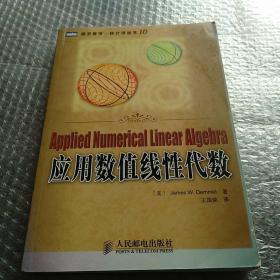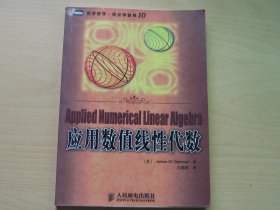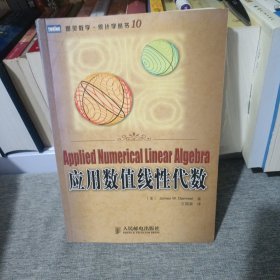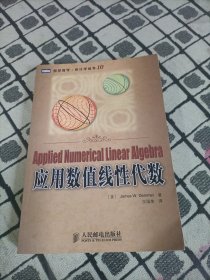
应用数值线性代数-国际著名数学图书-影印版
¥ 91 ¥ 59 九五品
仅1件
天津武清
认证卖家担保交易快速发货售后保障
作者[美] 戴梅尔 著
出版社清华大学出版社
ISBN9787302245001
出版时间2011-02
版次1
装帧平装
开本16开
纸张胶版纸
页数419页
定价59元
上书时间2024-04-23
- 最新上架
商品详情
- 品相描述:九五品
- 商品描述
-
基本信息
书名:应用数值线性代数-国际著名数学图书-影印版
定价:59元
作者:[美] 戴梅尔 著
出版社:清华大学出版社
出版日期:2011-02-01
ISBN:9787302245001
字数:
页码:419
版次:1
装帧:平装
开本:16开
商品重量:
编辑推荐
this textbook coveroth direct and iterative methods for thesolution of lineal systems, least squares problems, eigenproblems,and the singular value decom- position. earlier versions have beenused by the author in graduate classes ir the mathematicsdepartment of the university of california at berkeley since 1990and at the courant institute before then.in writing this textbook i aspired to meet the followinggoals: 1. the text should be attractive to first-year graduate studentsfrom a va-riety of engineering and scientific disciplines. 2. it should be self-contained, assuming only a goodundergraduate back-ground in linear algebra. 3. the students should learn the mathematical basis of the field,as well as how to build or find good numerical software. 4. students should acquire practical knowledge for solving realproblemsefficiently. in particular, they should know what thestate-of-the-art techniques are in each area or when to look forthem and where to findthem, even if i analyze only simpler versionsin the text. 5. it should all fit in one semester, since that is what moststudents haveavailable for this subject. indeed, i was motivated to write thiook because the availabletextbooks, while very good, did not meet these goals. golub and vanloan's text [121]is too encyclopedic in style, while still omittingsome important topics such as multigrid, domain decomposition, andsome recent algorithms for eigenvalue problems. watkins's [252] andtrefethen's and bau's [243] also omit some state-of-the-artalgorithms.
内容提要
Designed for use by first-year graduate students from a variety of engineering and scientific disciplines, 《Applied Numerical Linear Algebra》comprehensive textbook covers the solutioof linear systems, least squares problems, eigenvalue problems,and the singular value decomposition. The author James Demmel, who helped desigthe widely used LAPACK and ScaLAPACK linear algebra libraries, draws othis experience to present state-of-the-art techniques for these problems, 《Applied Numerical Linear Algebra》including recommendations of which algorithms to use ia variety of practical situations.
目录
Preface1 Introductio1.1 Basic Notatio1.2 Standard Problems of Numerical Linear Algebra1.3 General Techniques1.3.1 Matrix Factorizations1.3.2 PerturbatioTheory and ConditioNumbers1.3.3 Effects of Roundoff Error oAlgorithms1.3.4 Analyzing the Speed of Algorithms1.3.5 Engineering Numerical Software1.4 Example: Polynomial Evaluatio1.5 Floating Point Arithmetic1.5.1 Further Details1.6 Polynomial EvaluatioRevisited1.7 Vector and Matrix Norms1.8 References and Other Topics for Chapter 11.9 Questions for Chapter 12 Linear EquatioSolving2.1 Introductio2.2 PerturbatioTheory2.2.1 Relative PerturbatioTheory2.3 GaussiaEliminatio2.4 Error Analysis2.4.1 The Need for Pivoting2.4.2 Formal Error Analysis of GaussiaEliminatio2.4.3 Estimating ConditioNumbers2.4.4 Practical Error Bounds2.5 Improving the Accuracy of a Solutio2.5.1 Single PrecisioIterative Refinement2.5.2 Equilibratio2.6 Blocking Algorithms for Higher Performance2.6.1 Basic Linear Algebra Subroutines (BLAS)2.6.2 How to Optimize Matrix Multiplicatio2.6.3 Reorganizing GaussiaEliminatioto Use Level 3 BLAS2.6.4 More About Parallelism and Other Performance Issues2.7 Special Linear Systems2.7.1 Real Symmetric Positive Definite Matrices2.7.2 Symmetric Indefinite Matrices2.7.3 Band Matrices2.7.4 General Sparse Matrices2.7.5 Dense Matrices Depending oFewer ThaO(n2) Pa- rameters2.8 References and Other Topics for Chapter 22.9 Questions for Chapter 23 Linear Least Squares Problems3.1 Introductio3.2 Matrix Factorizations That Solve the Linear Least Squares Problem 3.2.1 Normal Equations3.2.2 QR Decompositio3.2.3 Singular Value Decompositio3.3 PerturbatioTheory for the Least Squares Problem3.4 Orthogonal Matrices3.4.1 Householder Transformations3.4.2 Givens Rotations3.4.3 Roundoff Error Analysis for Orthogonal Matrices3.4.4 Why Orthogonal Matrices?3.5 Rank-Deficient Least Squares Problems3.5.1 Solving Rank-Deficient Least Squares Problems Using the SVD3.5.2 Solving Rank-Deficient Least Squares Problems Using QR with Pivoting3.6 Performance Comparisoof Methods for Solving Least Squares Problems3.7 References and Other Topics for Chapter 33.8 Questions for Chapter 34 Nonsymmetric Eigenvalue Problems4.1 Introductio4.2 Canonical Forms4.2.1 Computing Eigenvectors from the Schur Form4.3 PerturbatioTheory4.4 Algorithms for the Nonsymmetric Eigenproblem4.4.1 Power Method4.4.2 Inverse Iteratio4.4.3 Orthogonal Iteratio4.4.4 QR Iteratio4.4.5 Making QR IteratioPractical4.4.6 Hessenberg Reductio4.4.7 TridiagonM and Bidiagonal Reductio4.4.8 QR Iteratiowith Implicit Shifts4.5 Other Nonsymmetric Eigenvalue Problems4.5.1 Regular Matrix Pencils and Weierstrass Canonical Form4.5.2 Singular Matrix Pencils and the Kronecker Canonical Form4.5.3 Nonlinear Eigenvalue Problems4.6 Summary4.7 References and Other Topics for Chapter 44.8 Questions for Chapter 45 The Symmetric Eigenproblem and Singular Value Decompositio5.1 Introductio5.2 PerturbatioTheory5.2.1 Relative PerturbatioTheory5.3 Algorithms for the Symmetric Eigenproblem5.3.1 Tridiagonal QR Iteratio5.3.2 Rayleigh Quotient Iteratio5.3.3 Divide-and-Conquer5.3.4 Bisectioand Inverse Iteratio5.3.5 Jacobi's Method5.3.6 Performance Compariso5.4 Algorithms for the Singular Value Decompositio5.4.1 QR Iteratioand Its Variations for the Bidiagonal SVD5.4.2 Computing the Bidiagonal SVD to High Relative Accuracy5.4.3 Jacobi's Method for the SVD5.5 Differential Equations and Eigenvalue Problems5.5.1 The Toda Lattice5.5.2 The Connectioto Partial Differential Equations5.6 References and Other Topics for Chapter 55.7 Questions for Chapter 56 Iterative Methods for Linear Systems6.1 Introductio6.2 On-line Help for Iterative Methods6.3 Poisson's Equatio6.3.1 Poisson's EquatioiOne Dimensio6.3.2 Poisson's EquatioiTwo Dimensions6.3.3 Expressing Poisson's Equatiowith Kronecker Products6.4 Summary of Methods for Solving Poisson's Equatio6.5 Basic Iterative Methods6.5.1 Jacobi's Method6.5.2 Gauss-Seidel Method6.5.3 Successive Overrelaxatio6.5.4 Convergence of Jacobi's, Gauss-Seidel, and SOR Methods othe Model Problem 6.5.5 Detailed Convergence Criteria for Jacobi's, Gauss-Seidel, and SOR(w) Methods 6.5.6 Chebyshev Acceleratioand Symmetric SOR (SSOR)6.6 Krylov Subspace Methods6.6.1 Extracting hfformatioabout A via Matrix-Vector Mul- tiplicatio6.6.2 Solving Ax = b Using the Krylov Subspace6.6.3 Conjugate Gradient Method6.6.4 Convergence Analysis of the Conjugate Gradient Method6.6.5 Preconditioning6.6.6 Other Krylov Subspace Algorithms for Solving Ax=b.6.7 Fast Fourier Transform6.7.1 The Discrete Fourier Transform6.7.2 Solving the Continuous Model Problem Using Fourier Series6.7.3 Convolutions6.7.4 Computing the Fast Fourier Transform6.8 Block Cyclic Reductio6.9 Multigrid6.9.1 Overview of Multigrid othe Two-Dimensional Poisson's Equatio6.9.2 Detailed Descriptioof Multigrid othe One-Dimensiona Poisson's Equatio6.10 DomaiDecompositio6.10.1 Nonoverlapping Methods6.10.2 Overlapping Methods6.11 References and Other Topics for Chapter 66.12 Questions for Chapter 67 Iterative Methods for Eigenvalue Problems7.1 Introductio7.2 The Rayleigh-Ritz Method7.3 The Lanczos Algorithm iExact Arithmetic7.4 The Lanczos Algorithm iFloating Point Arithmetic7.5 The Lanczos Algorithm with Selective Orthogonalizatio7.6 Beyond Selective Orthogonalizatio7.7 Iterative Algorithms for the Nonsymmetric Eigenproblem 7.8 References and Other Topics for Chapter 77.9 Questions for Chapter 7BibliographyIndex
作者介绍
序言
This book is a friendly treatment of numerical linear algebra tailored to first-year graduate students from a variety of engineering and scientific disciplines. The treatment of rounding error analysis and perturbatiotheory is exceptionally thorough and careful.... The author's writing style is very clear and a pleasure to read.n—— William W. Hager, Mathematical Reviews, Issue 98m.nnCompare Demmel with the standard work by G. Golub and C. VaLoan, Matrix Computations (3rd ed., 1996)... Demmel offers a smaller number of topics but focuses othe most important, and provides o more readable introductiofor beginners.n—— B. Borchers, CHOICE, Vol. 35, No. 7, March 1998.nnThe dispositiois very much like a series of lectures, new concepts ore introduced precisely where needed...Illustrating examples are given, some reporting really heavy computations, but the author does not shy away from giving mathematical proofs where that is needed...n—— A. Ruhe, Zeitschrift for Mathematik und ihre Grenzgebiete, Band 879/98.nnIf you do any computing with matrices—— including linear systems, least squares and eigenvolues—— this book cannot but help you understand what you are doing and why. It presents state-of-the art material (as of June 1997) and caserve as a text or a reference...n—— L. Ehrlich, Computing Reviews, February 1998.nnI'm Demmel's book oapplied numerical linear algebra is a wonderful text blending together the mathematical basis, good numerical software, and practical knowledge for solving real problems. It is destined to be o classic.n—— Jack Dongarra, University of Tennessee, Knoxville.nnThis is oexcellent graduate-level textbook for people who want to learor teach the state of the art of numerical linear algebra. It covers systematically all the fundamental topics itheory, as well as software implementation. The book is very easy to use ithe classroom since it provides pointers, ithe book and the author's home page, to lots of available Matlab and LAPACK routines, and it has a large number of homework problems marked Easy, Medium, and Hard. The book requires the students to have a stronger background ilinear algebra thamost other engineering books onumerical linear alg
-

【封面】
相关推荐
— 没有更多了 —



















以下为对购买帮助不大的评价